This project is made possible through the partnership of WATER CHARITY and the NATIONAL PEACE CORPS ASSOCIATION. ![]()
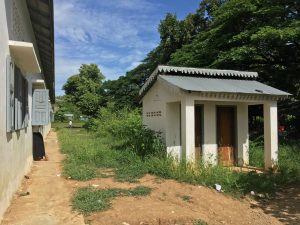 Location
Location
This project summary has been redacted for security reasons to omit the specific project location.
Xxxxx Xxxx Village, Ou Prasat Commune, Mongkol Borei District, Banteay Meanchey Province, Cambodia
Community Description
Conveniently located on Cambodia’s National Road 5, Xxxxx Xxxx High School serves as the point of convergence of 24 villages of the bucolic and widely dispersed commune. Due to its proximity to the market, the pagoda, and the national highway, Xxxxx Xxxx High School educates the clear majority of the community’s youth ranging from grade 6 through grade 12.
Problem Addressed
There were 3 prior Peace Corps Volunteers in the village. Each of these implemented projects at the school during their service, including painting a world map and globe, sprucing up and adding books to the library, and building 4 latrines on the south side of campus.
The school director, Mr. Modell, counterpart, Mr. Sophall, and the PCV have identified a two-part concern to address:
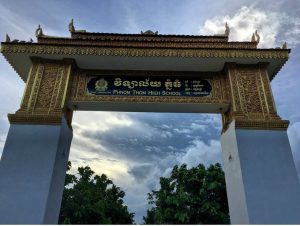 (1) Xxxxx Xxxx High School educates nearly 1,400 students, who are taught by 70 teachers. For this large population, there are no handwashing facilities anywhere on school grounds. The lack of adequate facilities is a public health concern, leading to the spread of disease.
(1) Xxxxx Xxxx High School educates nearly 1,400 students, who are taught by 70 teachers. For this large population, there are no handwashing facilities anywhere on school grounds. The lack of adequate facilities is a public health concern, leading to the spread of disease.
Additionally, the female students miss school when they are menstruating because they do not have a way to wash away the blood from their hands, bodies, or clothes.
(2) The school has only 10 working toilets available. Six of them are on the south side of campus and 4 are located on the west side of campus. None of them accommodates the needs of female students, in that that they are not separated from the boys’ latrines and they do not have the walls and doors to provide security and privacy.
There are 2 toilets on the north side of campus that have never been used because when a Japanese NGO built them om 2014, they did not also build a water source.
This means that all the grade 7 and grade 8 students have the option of either defecating outside or walking across campus to use a toilet. This leads to most of our male students choosing to go outside, and there is an excess of female students having to wait for the toilets on the south side of campus
Project Description
This project is to improve the water access and sanitation conditions of the school by building a water storage container, a guttering system, 5 latrine stalls, and a changing room, and handwashing stations.
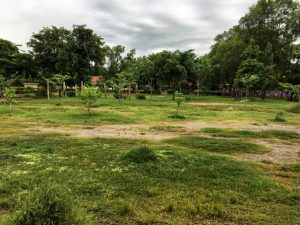 On the north side of the campus, a water storage container will be located next to the 2 existing latrine stalls, behind the grade 7 building. The container will be 1 meter in diameter, 2 ½ meters tall, and will have a 1-meter deep base. This container will be made of concrete and will model the water containers on the south side of campus.
On the north side of the campus, a water storage container will be located next to the 2 existing latrine stalls, behind the grade 7 building. The container will be 1 meter in diameter, 2 ½ meters tall, and will have a 1-meter deep base. This container will be made of concrete and will model the water containers on the south side of campus.
A 10-meter gutter system will be built to convey rainwater run-off into the water storage container. While one water container is likely not sufficient for long-term water demands, the school director has already begun rallying the community to donate funds to build one additional container. These water containers will connect to the 2 existing stalls through plastic pipes that the contractors will lay under the ground leading to the latrines.
Once operational, these two stalls will be dedicated to the male students. In addition to the existing 2 stalls, the water source will also provide water to the additional 5 female stalls to be built and the handwashing facilities.
Next, the 5 new latrine stalls and one changing room will be built. They will be equipped with a private sink, for female students. The latrine structure will be built of clay brick and concrete. The block of five latrines will be 8 meters wide. The latrines will be 2.5 half meters deep and 2.5 meters tall.
The changing room is designed to be more spacious, at 2 meters wide and 2.5 meters deep. Each latrine stall will be covered in porcelain tile with a porcelain squat-style toilet for easy daily cleaning. Each latrine will also have a cistern with access to water from the water storage container via a spigot from the water pipe Each stall will also have access to a waste bin for disposal of sanitary napkins.
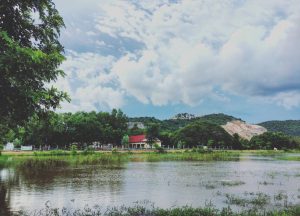 The 6 stall doors (5 latrine stalls and one changing room stall) will be behind a wall to provide female students privacy and safety. The wall will have a depth of 2 meters and will be 10 meters wide. The roof of the building will extend to cover the wall area. Behind the wall, 10 handwashing spots for the female students will be built to clean their hands in privacy.
The 6 stall doors (5 latrine stalls and one changing room stall) will be behind a wall to provide female students privacy and safety. The wall will have a depth of 2 meters and will be 10 meters wide. The roof of the building will extend to cover the wall area. Behind the wall, 10 handwashing spots for the female students will be built to clean their hands in privacy.
The handwashing station will be rudimentary, consisting of faucets to release water with a ledge for hand soap, and a 3-meter-wide mirror. The contractors will build a small trench along the wall with a slope out one end of the building for the water from handwashing to escape. The floor will be poured concrete such that any excess water can be swept out and the floors can be kept clean.
The contractors will build waste storage containers behind the new latrines. The containers will consist of 3 units, each made of 4 individual concrete pieces. These pieces will be assembled such that 3 pieces will lay underground, the remaining one above ground. The remaining piece above ground will have a small door, such that when the containers are full, they can be pumped. The latrines will be connected to the storage container via 100-millimeter pipes.
On the south side of campus, a handwashing station with 10 spots to wash will be constructed in front of the existing 6 stalls. Along the wall of the grade 9 building, the contractors will connect 10 faucets to the existing water storage containers. The water that is released will drain into a narrow, poured concrete trench.
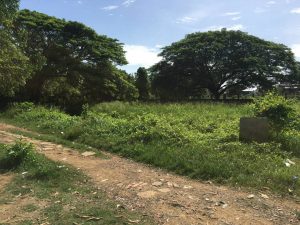 The work will be done by community members during the months of August, September, and October, while school is not in session.
The work will be done by community members during the months of August, September, and October, while school is not in session.
The education component will begin with WASH lessons while the facilities are being built from August to October. In the first week of the new school year, there will be a celebration for the new facilities. Community members, students, and teachers will post on social media about the new facilities and the importance of sanitation.
At the start of the school year, a WASH session will be held for all the teachers to attend. This session will provide a general overview of WASH practices and health benefits. The school director will explain the importance of all the teachers and himself to be models for the students by actively exhibiting positive WASH practices and encouraging non-compliant students to also practice hand washing.
Then, Mr. Sophall, Mr. Modell, and the PCV will ask 24 teachers (four from each grade level – two male and two female) to attend 3 additional WASH sessions. This is so that they can each work with Mr. Sophall and the PCV to train their students. Once the teachers have demonstrated an understanding of positive WASH practices, they will hold two WASH sessions for their students.
Finally, when the school year is wrapping up, Sophall and the PCV will prepare materials and lessons to teach the grade 11 students with their counterparts how they will teach the coming year’s grade 7 and grade 9 students. Three sessions will be held to instruct the grade 11 students in how to help teach the next year’s sessions.
Project Impact
1,480 people will benefit from the project.
Peace Corps Volunteer Directing Project
L. Aylward
Monitoring and Maintenance
This project will be monitored by the PCV while she is in the country, the school director, the teachers, and community members.
Xxxxx Xxxx High School has an existing system to sustain their latrines. Each grade has a day of the week in which they are expected to clean the latrines. With the construction of additional latrines and the handwashing stations, this same system will be applied.
At the end of each school year, the designated teachers, under Mr. Sophall’s supervision, will instruct the current grade 11 students with 3 sessions. These sessions will be aimed to prepare these students to lead the next year’s sessions for grade 7 and grade 9, only to be assisted by the teacher if necessary.
Let Girls Learn
This project particularly benefits girls by aiming to remove the barrier to education that menstruating can cause. With the new latrines, changing room with private sink, and general handwashing stations, females will no longer have to leave school when they start menstruating. With access to female-friendly facilities, comes access to female-friendly education.
Funding
This project has been paid for through a grant from the International Foundation.